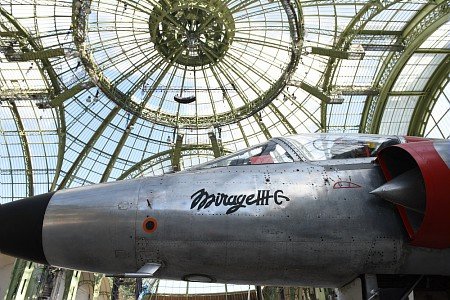« La Conquête de l’air » raconte l’histoire de l’aviation sur écran XXL
Dassault-Aviation has developed avionics and plenty of aircraft since the Eclair propeller in 1916 (interview in French, and same post in French thereafter):
100 ans de l’hélice Eclair – Bourget 2015… par Dassault-Aviation
Marcel Dassault was one of the greatest engineers in aviation history. He studied aeronautics in Paris, in the Higher Aeronautics and Mechanical Building School – now SUPAERO – in 1913, in the same entry as Mikhail Gurevitch who designed the MiG-1, MiG-15, and MiG-21. Dassault developed – as explained by Luc Berger, the Dassault-Aviation historian, in the video – a far better propeller for he had found out a lack of efficiency in the propellers of the Caudron G.3 aeroplanes. Dassault called his masterpiece « Hélice Éclair » (Lightning propeller). It is deemed to be the first line-production propeller, and the best one at that time. Georges GUYNEMER and Maxime LENOIR were among the first aces to use the Eclair on their SPAD VII and Nieuport. Dassault produced the MD 315 Flamant twin engine just after WWII. Then, came the first French fighter jet, the MD 450 Ouragan as early as 1949. Marcel Dassault used to say:
« For an airplane to fly well, it must be beautiful. »

And Dassault kept building so many graceful and sleek aircraft: Mystère, Etendard, Mirage, Falcon, and of course the magnificent Rafale. Dassault has even tested a high-tech drone called nEUROn. Contrary to the common belief, three quarters of Dassault-Aviation’s production is dedicated to civilian aviation and more particularly executive jets. With a strength of 12,000, and 8,000 aircraft delivered throughout the world since 1945, Dassault is a key market player on a global scale. Dassault-Aviation is 100 years old. Paris is to foster a huge show – La Conquête de l’Air – for this major event in one of its most splendid venues – le Grand palais – from April 9th till 14th, 2016. You can book here_>>>>> For further information about Dassault history, excellent gift idea, 2 books here:_>>>>>
EN FRANÇAIS:
Dassault développe de l’avionique et de nombreux avions depuis l’hélice Eclair en 1916. (voir l’interview en français en haut de l’article)
Marcel Dassault était un des plus grands ingénieurs de l’histoire de l’aviation. Il fit ses études d’aéronautique en 1913 à Paris à l’École supérieure d’aéronautique et de construction mécanique, l’ancêtre de SUPAERO, dans la même promotion que Mikhail Gourevitch, celui même qui concevait ensuite les MiG-1, MiG-15 et MiG-21. Dassault développa (commme l’explique Luc Berger, historien spécialiste de Dassault, dans la vidéo) une bien meilleure hélice car il avait découvert sur les Caudrons G.3 un manque d’efficacité à ce niveau. Marcel Dassault baptisa son chef d’oeuvre l’hélice Éclair et elle fût sans doute la première à être produite en chaîne à cette époque. Georges GUYNEMER et Maxime LENOIR furent parmi les premiers as à utiliser l’Éclair sur leur SPAD VII et Nieuport 17. Après la guerre de 39/45, Dassault produisait le bimoteur MD 315 Flamant. Ensuite, vint le premier chasseur français à réaction, le MD 450 Ouragan, dès 1949. Jadis, Marcel Dassault disait:
« Pour qu’un avion vole bien, il faut qu’il soit beau. »

Et Dassault poursuivit sa conception de tant d’avions aux lignes gracieuses et épurées: Mystère, Etendard, Mirage, Falcon, et bien sûr le magnifique Rafale. Dassault a même testé en 2012 un drone à la pointe de la technologie, le nEUROn. Contrairement aux idées reçues, les trois quarts de la productin de Dassault-Aviation’s production est tournée vers l’aviation civile et plus particulièrement les jets d’affaire. Dassault et ses 12 000 employés et qui a livré 8 000 avions depuis 1945 à travers le monde, est un acteur majeur du marché mondial.
Dassault-Aviation à l’occasion de ses 100 ans fait les choses en grand au coeur de Paris dans un show, La Conquête de l’Air, dans un de ses plus majestueux endroits, le Grand palais du 9 au 14 avril 2016. Vous pouvez réserver ici_>>>>> Pour plus d’information sur Dassault, en plus d’une excellente idée de cadeau, voici deux livres ici:_>>>>>

